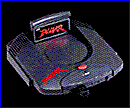| |

Atari Jaguar Technical Specifications
Hardware Specs for Atari's Jaguar System.
Physical dimensions:
Size: 9.5" x 10" x 2.5"
Controls:
Power on/off
Display:
Resolution up to 800 x 576 pixels
24-bit "True Color" display with 16,777,216 colors
simultaneously
Multiple-resolution, multiple-color depth objects
(monochrome, 2-bit, 4-bit, 8-bit, 16-bit, 24-bit)
can be used simultaneously
Ports:
Cartridge slot/expansion port (32 bit)
RF video output Video edge connector (video/audio output)
(supports NTSC and PAL; provides S-Video, Composite, RGB outputs,
accessible by optional add-on connector)
Two controller ports Digital Signal Processor port
(includes high-speed synchronous serial input/output)
Controllers:
Eight-directional joypad
Size 6.25" x 5" x 1.6", cord 7 feet
Three fire buttons A, B, C
Pause and Option buttons
12-key keypad (accepts game-specific overlays)
The Jaguar has five processors, which are contained in three
chips.
Two of the chips are proprietary designs, nicknamed
"Tom" and "Jerry".
The third chip is a standard Motorola 68000 used as a coprocessor.
Tom and Jerry are built using an 0.5 micron silicon process.
Tom
50,000 transistors, 208 pin
Graphics Processing Unit (processor 1) (!nl)) 32-bit RISC
architecture (32/64 processor)
64 registers of 32 bit wide
Has access to all 64 bit of the system bus
Can read 64 bit of data in one instruction
Rated at 26.591 MIPS (million instructions per second)
Runs at 26.591 MHz
4K byte of zero wait-state internal SRAM
Performs a wide range of high-speed graphic effects
Programmable
Object processor (processor 2)
64-bit RISC architecture
Programmable processor that can act as a variety of different
video architectures, such as a sprite engine, a pixel-mapped
display,
a character-mapped system, and others.
Blitter (processor 3)
64 bit
Performs high-speed logical operations
Hardware support for Z-buffering and Gouraud shading
DRAM memory controller(!nl) 64 bit
Accesses the DRAM directly
Jerry
600,000 transistors, 144 pin
Digital Signal Processor (processor 4)
32 bits (32-bit registers)
Rated at 26.6 MIPS (million instructions per second)
Runs at 26.6 MHz
Same RISC core as the Graphics Processing Unit
8K bytes of zero wait-state internal SRAM
CD-quality sound (16-bit stereo)
Number of sound channels limited by software
Full stereo capabilities
Wavetable synthesis, FM synthesis, FM Sample synthesis, and AM
synthesis
A clock control block, incorporating timers, and a UART
Joystick control
Motorola 68000 (processor 5)
Runs at 13.295MHz
General purpose control processor
Communication is performed with a high speed 64-bit data bus,
rated at 106.364 megabytes/second. The 68000 is only able to
access
16 bits of this bus at a time.
The Jaguar contains two megabytes (16 megabits) of fast page-mode
DRAM,
in four chips with 512 K each. Game cartridges can support
up to six megabytes (48 megabits) of information.
The Jaguar uses 24-bit addressing, and is reportedly capable of
accessing data as follows:
Six megabytes cartridge ROM
Eight megabytes DRAM
Two megabytes miscellaneous/expansion
Compressed cartridge data can be uncompressed in real-time,
and ratios of up to 14:1 have been cited.
In theory, a Jaguar cartridge can store up to 84 megabytes
(672 megabits) of data, though actual results will vary widely.
Compression is performed with JagPEG, an enhanced JPEG
image decompression mechanism.
Other Jaguar features:
Networking of up to 32 Jaguar units available.
The two controller ports can be expanded to support of more as two
controllers
Digital and analog interfaces
Keyboards, mice, and light guns are possible
Expansion port allows connection to cable TV and other networks
Digital Signal Processor port allows connection to modems and
digital
audio peripherals
One megabyte per second serial interface
9600 baud, RS-232 serial port (accessible with optional interface)
General-purpose I/O bits via the cartridge port
Can accomodate future expansions of different processor types, I/O
types, video types, and memory types and/or quantities.


Copyright © Robert Schaffner (webmaster@doitarchive.de)
Letzte Aktualisierung am 28. Juli 2001
|
